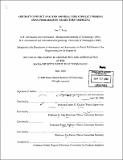Aircraft conflict analysis and real-time conflict probing using probabilistic trajectory modeling
Author(s)
Yang, Lee C
DownloadFull printable version (10.98Mb)
Other Contributors
Massachusetts Institute of Technology. Dept. of Aeronautics and Astronautics.
Advisor
James K. Kuchar.
Terms of use
Metadata
Show full item recordAbstract
Methods for maintaining separation between aircraft in the current airspace system have been built from a foundation of structured routes and evolved procedures. However, as the airspace becomes more congested and the chance of failures or operational error become more problematic, automated conflict alerting systems have been proposed to help provide decision support and to serve as traffic monitoring aids. The problem of conflict detection and resolution has been tackled from a number of different ways, but in this thesis, it is recast as a problem of prediction in the presence of uncertainties. Much of the focus is concentrated on the errors and uncertainties from the working trajectory model used to estimate future aircraft positions. The more accurate the prediction, the more likely an ideal (no false alarms, no missed detections) alerting system can be designed. Additional insights into the problem were brought forth by a review of current operational and developmental approaches found in the literature. An iterative, trial and error approach to threshold design was identified. When examined from a probabilistic perspective, the threshold parameters were found to be a surrogate to probabilistic performance measures. To overcome the limitations in the current iterative design method, a new direct approach is presented where the performance measures are directly computed and used to perform the alerting decisions. The methodology is shown to handle complex encounter situations (3-D, multi-aircraft, multi-intent, with uncertainties) with relative ease. Utilizing a Monte Carlo approach, a method was devised to perform the probabilistic computations in near realtime. Not only does this greatly increase the method's potential as an analytical tool, but it also opens up the possibility for use as a real-time conflict alerting probe. A prototype alerting logic was developed and has been utilized in several NASA Ames Research Center experimental studies.
Description
Thesis (Ph.D.)--Massachusetts Institute of Technology, Dept. of Aeronautics and Astronautics, 2000. Includes bibliographical references (p. 177-186).
Date issued
2000Department
Massachusetts Institute of Technology. Department of Aeronautics and AstronauticsPublisher
Massachusetts Institute of Technology
Keywords
Aeronautics and Astronautics.